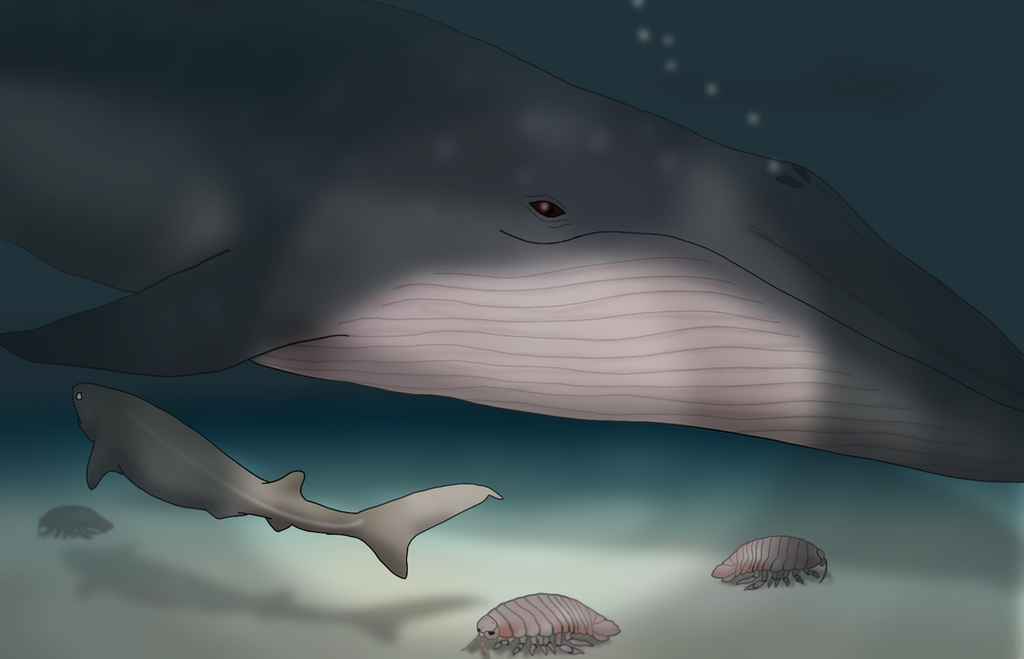HOME | DD
 Olmagon — Depths of the Gulf
Olmagon — Depths of the Gulf

#chondrichthyes #animal #animalart #animaldrawing #balaenoptera #cetacean #crustacean #dark #deepsea #fish #flashlight #invertebrate #isopod #mammal #marine #marinemammal #shark #twilightzone #underwater #ungulate #whale #deepseacreature #bathynomus #mesopelagic #hexanchus #giantisopod #sixgillshark #worldwhaleday #balaenopterid #riceswhale
Published: 2022-02-21 00:54:19 +0000 UTC; Views: 28130; Favourites: 272; Downloads: 6
Redirect to original
Description
In the deep waters of the Gulf of Mexico off the western coast of Florida, the creatures of the dark deep seabed comes across an endangered and rare giant. While the Atlantic sixgill shark (Hexanchus vitulus) is already 1.7 meters long and quite large for an animal living at this depth, it is dwarfed by a Rice's whale (Balaenoptera ricei) that grows over 12 meters long. The whale spends nights closer to the surface, but by day it is found in much deeper areas and closer to the seabed, where it could come across the deep-water sixgill shark and the giant isopods (Bathynomus giganteus) crawling across the bottom.Drawing made for World Whale Day (February 20). While new animal species are still being discovered and described all the time, nowadays these are usually small creatures like insects or lizards in remote areas like jungles. However, there are still instances of much larger animals being discovered in the 21st Century, though these are usually split from previously-known species. For example, last year in 2021 a population of baleen whales from the Gulf of Mexico formerly thought to be Bryde's whales (Balaenoptera brydei) was found to instead be a seperate distinct species that was named the Rice's whale (B. ricei).
Genetic differences and the shape of the nasal bone has shown these whales are indeed a seperate species from the Bryde's whale, and Rice's whale is found only in the northern parts of the Gulf of Mexico off the coast of Florida and Alabama. Rice's whale also shows different behavior: whereas Bryde's whale feeds near the surface for small schooling fish like sardines, Rice's whale feeds at depths of upto 271 meters during the day and comes closer to the surface at night instead. It is still unclear what it is feeding on at such depths, but since lanternfish are common there it may be that. I haven't seen any images of the Rice's whale in deep dark waters (it was found out they get that deep by tagging an individual) but considering how remote and inaccessible the deep sea is, that's understandable. However if photos are so hard to get than I just had to make sure at least one illustration of it exists and so I drew this one diving near the deep sea bed.
Unfortunately, while we have only described it a year ago, Rice's whale is already a critically endangered species and while the exact population is uncertain, it is below 100 individuals and possibly less than 50 mature adults, making it one of the most endangered animals alive. Facing threats from noise pollution, ship collisions and most of all oil spills, the future for this species unfortunately looks grim and it could well go extinct within our lifetimes (hell, one more big oil spill in their range could kill them all out at once). Such a shame that this animal could so easily die out and is already so endangered.
Diving to such great depths, Rice's whale could encounter some other deep-sea creatures that inhabit the twilight zone of the Gulf of Mexico. One is the Atlantic sixgill shark, a hexanchid shark that grows 1.4 to 1.8 meters long. It was previously thought to be a population of the bigeyed sixgill shark (Hexanchus nakamurai), but in 2019 was found to be a seperate species based on molecular data. Also found in the deep bottoms of the Gulf is the giant isopod, a huge species of isopod (the crustacean order that also includes woodlice/ roly polies and sea slaters) that is known to grow upto 50 centimeters long (but more commonly under 40 centimeters long). They are deep-sea scavengers that eat mostly carrion from dead animals that sank to the bottom, but have been known to hunt sponges and sea cucumbers (and Doritos i.kym-cdn.com/entries/icons/or… ).
Related content
Comments: 21

👍: 0 ⏩: 1

👍: 0 ⏩: 0

👍: 0 ⏩: 1

👍: 0 ⏩: 1

👍: 1 ⏩: 1

👍: 0 ⏩: 0

👍: 0 ⏩: 1

👍: 0 ⏩: 1

👍: 1 ⏩: 0

👍: 0 ⏩: 1

👍: 1 ⏩: 0

👍: 0 ⏩: 1

👍: 0 ⏩: 1

👍: 0 ⏩: 1

👍: 0 ⏩: 1

👍: 0 ⏩: 0

👍: 0 ⏩: 1























